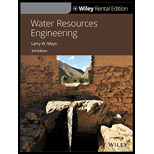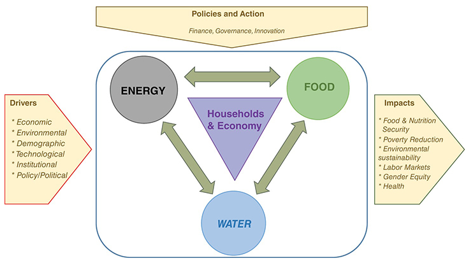
Concept explainers
Between 2009 and 2050, as the world population is expected to increase by 2.3 billion, urban populations are projected to grow by 2.9 billion-from 3.4 to 6.3 billion (UNDESA, 2009). Urban areas are therefore expected to absorb all of the world’s population growth over the next four decades, while also drawing in some of the rural population. Furthermore, most of the urban population growth will be concentrated in the cities and towns of less developed regions that already face enormous backlogs in shelter, infrastructure, and services, as well as insufficient drinking water supply, deteriorating sanitation, and increasing environmental pollution. What would you say are the most important factors of water resources sustainability that must be studied to handle this urban growth, particularly in the less developed regions?

Figure P2.2.5 The water, energy, and food nexus perspective. Reproduced with permission from the International Food Policy Research Institute www.ifprl.org. The original report from which this figure comes can be found online at http://ebray.ifprl.org/edm/ref/collection/p15738coll2/id/131154.
(Source: Adaptations by Al-Riffal, et al, (2017) of Hoff (2011) and von Braun (2015).)
Want to see the full answer?
Check out a sample textbook solution
- Please solve this and make sure you show all of your work, Thank you for your help!arrow_forward15'-0" 15'-0" Architect specifications: 1) Superimposed dead load (including finishes, partition, mep etc) for each floor are shown next page. 2) The facade weight is 200 plf and it's all around the building, the parapet weight at the roofs is 100 plf. Don't forget to add these loads at the perimeter beams. 3) Wind Load is 30 psf 4) Use steel or LVL for beams, TJI of common wood for joists. 5) Submit your calc package by Sunday May 11th ALL STRUCTURAL ITEMS IN RED ARE PART OF THE GRAVITY SYSTEM ALL STRUCTURAL ITEMS IN BLUE ARE PART OF THE LATERAL SYSTEM I 10'-0" 2 10'-0" 10'-0" B I I I LAYOUR FOR OFFICES Things Required Dead and Live Load Schedule Gravity design for office floor - Load calculations (DL + LL + facade load if on perimeter) Beam sizing Joist spacing/type (TJI or LVL) Provide calculations for: Reaction forces Maximum moments Shear • Beam sizes (steel or LVL) Key Map of elements (your office layout plan with beam/joist marks) Iarrow_forwardplease solve the problem in the picture make sure you show all of your work, thank you so much for your help!arrow_forward
- Please solve the question in the picture make sure you show all of your work and show every step you do please. Thank you so much for your help!arrow_forwardPlease answer the question in the picture. solve for the ground level and also for the 2nd level please. Make sure to show all of your work. Thank you for your help!arrow_forwardQ3: Assuming the length of all vehicles is 6 m and the road length is 300 m, determine: SMS, TMS, Density, average spacings between vehicles and average headway at A- A section. 50 kph Veh 4 70 m 40 kph Veh 3 60 m 30 kph Veh 2 20m 25 kph A Veh 1 Traffic direction A (40 marks)arrow_forward
- The drainage system shown in fig 14.35 is designed to collect the stormwater from 3 atreas The areas runoof coefficients and overland flow times are as follows The rainfall intensity i (mm/h) as a function of rainfall duration t(min) is i =1.12/t+110 The flow time in sewer 1-2 is 2min and in sewer 2-3 is 2.5 minarrow_forwardPlease answer the question from the picture, show each step and explain please. Thank you so mucharrow_forwardFigure 1 shows the plan view of an Exhibition Hall with dimensions L1 x L2. The structure is to be constructed in a coastal region which will be exposed to mostly mild environmental conditions and should provide a 1.5-hour fire resistance. It is known that the underlying foundation soil contains sulphate and other organic compounds. The layout of the structure consists of portal frames which are spaced evenly along the L2 direction. The frames are to support a slab of thickness (t) that will cover the full area of the hall plan. The dead and live loads applied on the slab are G and Q (kPa), respectively.arrow_forward
- A sample of Achilles saturated with water has a mass of 1710 g. After heating in an oven, a constant mass of 1815 g is obtained. The density of solid Achilles seeds is 2.78 g/cm3. We are asked to calculate: a) The water content and void ratio b) The porosity and specific gravity of the clayey soil c) The wet density of the clayey soil, the corresponding dry density and dry densityarrow_forward8. A prestressed concrete beam is subjected to the following stress distributions: Pi is the initial prestressing force, Pe is the effective prestressing force, M, is the bending moment due to self- weight, Ma and M, are the dead load and live load bending moment, respectively. The concrete has the following properties: fr = 6000 psi and fri = 4200 psi +250 -85 -2500 +550 Pe+ Mo+Ma+Mi P alone P₁+ Mo -2450 -3500 Stress at midspan +210 +250 P, alone Pe alone -2500 -3500 Stress at ends Using Table 22.1, evaluate whether the stresses at the center of the span and the end of the span comply with the permissible stress limits. The beam is classified as U-class. Provide justifications for each condition listed in the table. Note: Calculated stresses are to be taken from the above diagram, and permissible stresses are to be calculated using Table 22.1. Compressive stresses immediately after transfer Tensile stresses immediately after transfer Compressive stresses under sustained and total…arrow_forward10. A short column is subjected to an eccentric loading. The axial load P = 1000 kips and the eccentricity e = 12 in. The material strengths are fy = 60 ksi and f = 6000 psi. The Young's modulus of steel is 29000 ksi. (a) Fill in the blanks in the interaction diagram shown below. (2pts each, 10pt total) Po Pn (1) failure range H 3" 30" Ast 6 No. 10 bars = P 22" I e H 3" (4) e = e small Load path for given e Radial lines show constant (2) eb (3) e large failure range Mn (5) e= Mo (b) Compute the balanced failure point, i.e., P and Mb.arrow_forward

 Traffic and Highway EngineeringCivil EngineeringISBN:9781305156241Author:Garber, Nicholas J.Publisher:Cengage Learning
Traffic and Highway EngineeringCivil EngineeringISBN:9781305156241Author:Garber, Nicholas J.Publisher:Cengage Learning Engineering Fundamentals: An Introduction to Engi...Civil EngineeringISBN:9781305084766Author:Saeed MoaveniPublisher:Cengage Learning
Engineering Fundamentals: An Introduction to Engi...Civil EngineeringISBN:9781305084766Author:Saeed MoaveniPublisher:Cengage Learning Fundamentals Of Construction EstimatingCivil EngineeringISBN:9781337399395Author:Pratt, David J.Publisher:Cengage,
Fundamentals Of Construction EstimatingCivil EngineeringISBN:9781337399395Author:Pratt, David J.Publisher:Cengage, Solid Waste EngineeringCivil EngineeringISBN:9781305635203Author:Worrell, William A.Publisher:Cengage Learning,
Solid Waste EngineeringCivil EngineeringISBN:9781305635203Author:Worrell, William A.Publisher:Cengage Learning, Residential Construction Academy: House Wiring (M...Civil EngineeringISBN:9781285852225Author:Gregory W FletcherPublisher:Cengage Learning
Residential Construction Academy: House Wiring (M...Civil EngineeringISBN:9781285852225Author:Gregory W FletcherPublisher:Cengage Learning





